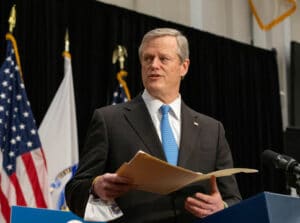
Gov. Charlie Baker held a State House press conference on Feb. 17, 2021 to announce that COVID-19 vaccine eligibility was expanding to include people age 65 and older. Photo by Sam Doran | State House News Service
Just hours after appearing before lawmakers critical of his administration’s rollout of COVID-19 vaccinations, Gov. Charlie Baker announced the state was loosening public health restrictions on restaurants and other businesses.
Capacity limits across all sectors with them – notably including restaurants – will increase to 50 percent. All capacity limits exclude employees. Restaurants will no longer have a percent capacity limit and will be permitted to host musical performances; 6-foot social distancing, limits of six people per table and 90 minute limits remain in place.
Indoor performance venues like concert halls and theaters will be allowed to reopen at 50 percent capacity with no more than 500 people allowed inside. Indoor recreational businesses like roller rinks and trampoline parks will also be able to reopen at 50 percent capacity.
The Baker administrations said the move, which puts Massachusetts back to Step 2 of Phase III of its reopening plan, will go into effect March 1 and is based on improving public health data. That puts restrictions back to where they were in October 2020, before a winter surge in COVID-19 cases linked in part to Thanksgiving.
The administration also announced that on March 22, if public health data continues to improve, the state will move to Step 1 of Phase IV of its reopening plan. That means ballparks and sports stadiums will reopen, and gathering limits for event venues and in public settings will increase to 100 people indoors and 150 people outdoors. Outdoor gatherings at private residences and in private backyards will remain at a maximum of 25 people, with indoor house gatherings remaining at 10 people.
The announcement comes as a range of public health measures continue to improve, even as many residents report frustrations with securing vaccine appointments and the Baker administration fields criticisms that it has not done enough to make sure residents of the state’s majority-Latino and majority-Black cities, towns and neighborhoods got sufficient access to vaccines. The positive test rate in Massachusetts fell below 2 percent this week for the first time since October, and currently sits at 1.89 percent.
At a meeting of the state legislature’s new Joint Committee on COVID-19 and Emergency Preparedness Thursday morning, committee co-chair Rep. Bill Driscoll asked Baker if, despite the stats he listed, he would characterize the state’s vaccine rollout as “a top 10 rollout.”
Massachusetts is tops in the nation for first doses administered per capita among states with five million or more people; the Bay State has administered more than three times more doses per capita than the European Union and more than five times more per capita than Canada; the state ranks second in the country for percentage of Black residents who have gotten at least one shot; and every county has vaccinated at least 56 percent of its residents 75 years or older, the governor said via videoconference from his ceremonial office in the State House.
“Unfortunately, these hopeful figures do not tell the whole story,” Driscoll said after himself referencing recent improvements in COVID-19 metrics here in his opening remarks. “These numbers hide the confusion caused by frequent pivots and course corrections, and the daily frustrations residents face trying to access the vaccine. Residents must book their appointments on cumbersome and flawed websites and hope their internet connection is stronger than the thousands of others competing for the same batch of limited appointments. The system benefits those with time, resources, and mobility and disadvantages those most vulnerable populations that have suffered disproportionately from this pandemic. It tries to prioritize efficiency over equity.”
Baker, in his prepared remarks and in response to questions from lawmakers, cited the constraints in the supply of the two federally-approved vaccines as the primary challenge and defended his administration’s decisions to prioritize groups that other states did not, like group home residents and staff, inmates and staff at prisons and jails, and all hospital workers.
“I think many states chose to pursue a variety of different approaches to this which makes it hard to draw really broad comparisons between states,” the governor said. “As I said in my remarks, Massachusetts chose early on to prioritize a number of communities and a number of professions that weren’t prioritized in other states that did make us look, if you just based it on the numbers, like a low performer relative to many other states that didn’t focus on those hard-to-reach populations that we chose to focus on.”
Driscoll invited Baker to return for more testimony in two weeks and Baker said he looked forward to it.
State House News Service contributed to this report.




 |
| 

